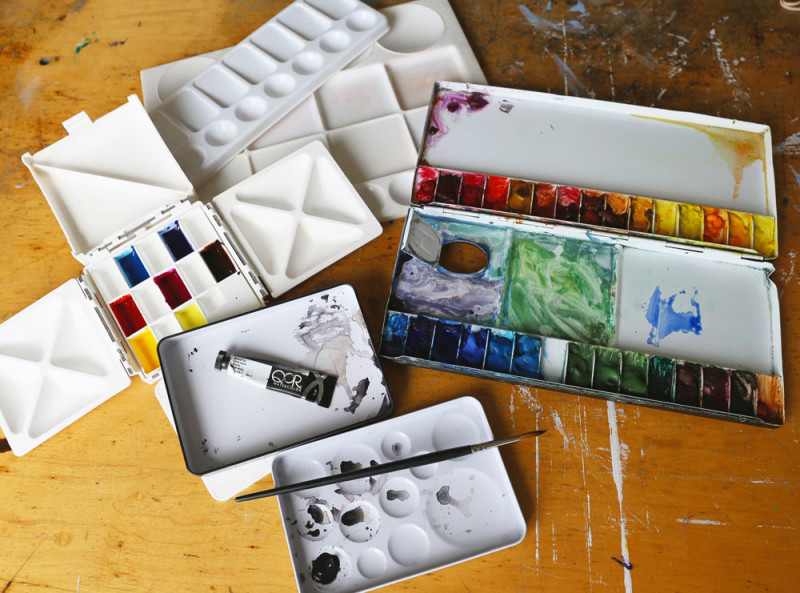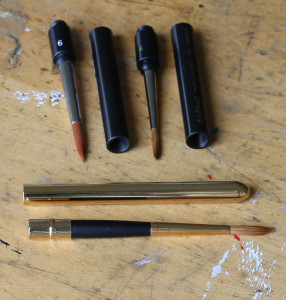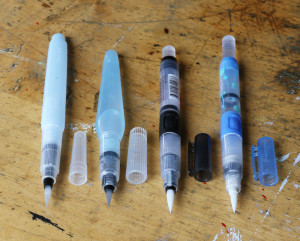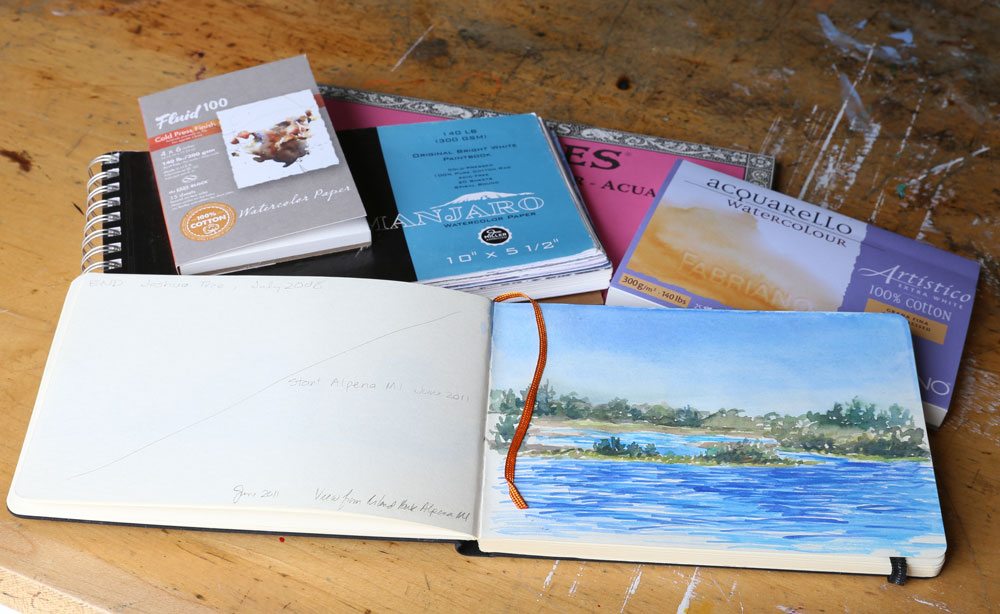When first painting with your watercolors outside, there are a few things you will definitely need, and other items that can ease your way: paint, a mixing surface or palette, water and water container, a brush, and watercolor paper on a support of some kind are the minimum things you need. Picnic tables, benches, boulders, stone fences, and the ground all provide sitting and painting areas if you travel light and do not want an easel. If you like to draw before painting, then add pens, pencils, erasers, and a sharpener to your tools. You can get by with one brush, but several will facilitate painting with varied techniques and quick color changes. Other supplies might include paper-friendly tape, paper towels or a clean rag, insect spray, sunscreen, a brimmed hat to keep the sun from your eyes, baby wipes or something similar to clean your hands, and water for you to drink while painting. It is easy to become dehydrated by sun and wind without realizing it when lost in painting. In addition, you will need something in which to carry your supplies.
Think about where you will be painting. Find a view that interests you, make sure the location will be safe, and find shade in which to work if possible. If you are in a populous area and do not like crowds watching you, position yourself in a less conspicuous place, or with your back to a wall. Do not block vehicle or foot traffic. If you feel overwhelmed by choices to paint, try zooming in on a single component, such as a doorway or a flower. This will help you become comfortable with a new location, and you can come back another time to paint a wider view, or more details as you wish.
Palettes
Palette designs are varied, from those that might hold a few half pans to those which can contain many colors. Think about what you wish to carry and what you might need. I have painted successfully en plein air with a single neutral color, and with palettes holding from three to over twenty colors. Start with a small range of paints, and expand as needed depending upon the location and the scale and intent of your painting. I usually transport the palette itself in a plastic zip lock bag to forestall wash water and damp paint making a mess in my painting kit.

Paints
A limited palette of colors allowing for a diversity of mixes might contain Cadmium Yellow Primrose (for greens), Cadmium Yellow Medium (for oranges), Transparent Pyrrole Orange (as a red-orange), Quinacridone Magenta (for purples), Ultramarine Blue (for Purples), and Manganese Blue (for greens). Adding an oxide such as Van Dyke Brown and a neutral like Payne’s Grey would provide ‘convenience’ mixes for browns and neutrals.
Brushes
For brushes, sometimes one is all that is needed. Other times, having a wide variety is good. Regular watercolor brushes are fine, although you might want to transport them taped inside a folded piece of cardboard to protect the bristles. Alternately, there are ‘travel brushes’ which have caps over the business end, or ‘water brushes’ which not only have caps, but also contain reservoirs that hold water. Try these before you go, as some of them leak. Experiment as you wish from painting trip to painting trip, and find what works best for you.



Papers
Your choices here are just as wide. There are excellent sketchbooks with watercolor-friendly papers, blocks of watercolor paper, or tear single sheets into the sizes you desire to take with you. I often have all of the above with me on a painting trip, and have found that clipboards work well to support smaller pieces of paper. When I am painting on my easel, I tack, staple, or clip larger sheets of watercolor paper to a piece of Homasote.

A Final Suggestion
I consider my painting trips as experiential processes and journeys of exploration. Whenever I paint in a new location, I find it beneficial to focus on enjoying the painting process and learning the environment, rather than on completing polished paintings. This might be a beneficial approach if painting en plein air is new to you. Focusing on the process of painting rather than the end result (the painting) may allow you to engage more freely in the experience of painting on location.
